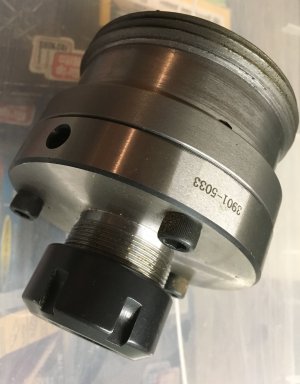- Joined
- Feb 1, 2015
- Messages
- 9,625
I bought a 5C collet because the comparatively small (2") nose diameter allowed me to get much closer with my tooling in certain circumstances. It also provides better runout specs compared to the three jaw chuck with similar setup times. It does take more time if changing collets though.
Another issue is the limited grip range of a 5C collet. Minimally, at least 37 collets would be required to cover the range from 1/16" to 1-1/8" by 1/32". Better would be 73 collets by 1/64". Purists would say that stock should be nominal to a few thousandths undersized. The limited grip range can be compensated for by wrap a piece of shim stock around the work to bring it within the collet grip range.
An ER32 or an ER40 collet chuck is an alternative to the 5C chuck. ER collets have a greater grip range so fewer collets are needed. The ER32 and ER40 collets have a maximum stock size of just over 3/4" and 1" respectively. Closing the collet is done by means of tightening a nut. ER collets are more expensive than 5C collets so the benefit of a reduced number of collets is offset somewhat.
Another issue is the limited grip range of a 5C collet. Minimally, at least 37 collets would be required to cover the range from 1/16" to 1-1/8" by 1/32". Better would be 73 collets by 1/64". Purists would say that stock should be nominal to a few thousandths undersized. The limited grip range can be compensated for by wrap a piece of shim stock around the work to bring it within the collet grip range.
An ER32 or an ER40 collet chuck is an alternative to the 5C chuck. ER collets have a greater grip range so fewer collets are needed. The ER32 and ER40 collets have a maximum stock size of just over 3/4" and 1" respectively. Closing the collet is done by means of tightening a nut. ER collets are more expensive than 5C collets so the benefit of a reduced number of collets is offset somewhat.


